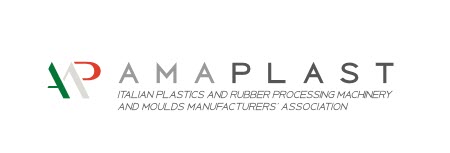
AMAPLAST reports Sustained Growth in Italian Plastics Machinery Foreign Trade
Imports up by 9.1%, exports by 14.6%: these are the results of the first half of 2017 with respect to the same period in 2016 based on the analysis of ISTAT foreign trade data by the Amaplast Statistical Studies Center.
The two trends point to further improvement in the positive balance of trade for the sector (by more than 1.1 billion euros), with an increase of seventeen percentage points compared to January-June 2016.
While imports have slightly slowed down with respect to year-end 2016 and the first months of 2017, sales abroad confirm the robust double-digit growth that has characterized the entire first half of 2017.
As regards exports – the main outlet for national production in the sector – Italian manufacturers may consider themselves satisfied both as regards the range of products and in terms of the geography of sales.
Performance by machine type
With the exception of negative performance in plants for mono- and multi-filament, blow moulding machines, and machines for foamed materials, all machine types have recorded marked improvement in foreign demand, and particularly extrusion lines (+17% over the previous year), flexographic printers (+23%), thermoforming machines (+37%), and moulds (+18%), just to mention some of the principal customs codes.
Performance by geography – Europe
As for outlets, Europe remains the principal destination market. Sales within the EU have increased by over twenty percentage points with respect to the first six months of 2016, and a similar upsurge is recorded across the rest of Europe generally. It is worth underscoring the positive performance in Russia, where the value of sales more than doubled from approximately 21 to nearly 50 million euros.
Performance by geography – the Americas
The Americas absorbed a fifth of Italian exports in the sector, with an increase on the order of ten percentage points, imputable mainly to growth in Latin American markets, with Brazil in the lead (+73%). The NAFTA countries, on the other hand, recorded more modest growth, due to a slowdown in sales to Mexico.
Performance by geography – Asia
Sales to Asian countries remained rather stagnant, conditioned by a drop in exports to the Middle East in general, and specifically to Saudi Arabia and Iran. Sales to the Far East did not fare much better, dragged down by the -12% recorded for China, which was certainly not offset by the +1% to India (just looking at the two principal markets in the area).
Performance by geography – Africa
While the aggregate sales to Africa are modest in value, Mediterranean countries and Sub-Saharan countries both recorded an increase approaching twenty percentage points.
“It should be noted,” points out the satisfied president of Amaplast Alessandro Grassi, “that the recovery in supplies to important historical markets such as Russian and Brazil, which were sputtering in the recent past due to their respective, well publicized economic and political problems, gives a quite significant boost in confidence for companies in our sector.”
“The end-of-June statistics highlighting continuing growth in exports for the sector,” continues Grassi, “are an important signal for Italian manufacturers of plastics and rubber processing machinery, equipment, and moulds, who thus have a more tangible perception of recovery in their market and can look forward to a new record in production and exports at year end. Companies also note a parallel recovery in the domestic market, sustained in part by the stimulus measures implemented by the Italian government to support investment by manufacturers within an “Industry 4.0” approach. Italian manufacturers of plastics and rubber processing machinery are ready to contribute to the process by providing cutting-edge, competitive systems.”
Confirming the above foreign trade statistics, the mid-year survey conducted at the end of July among Amaplast member companies, comparing the first half of 2017 with the same period in 2016, revealed a positive trend both in turnover (rising for 45% of the interviewees and stable for 51%) and current orders (improving for 51% of those surveyed and stable for 35%).






